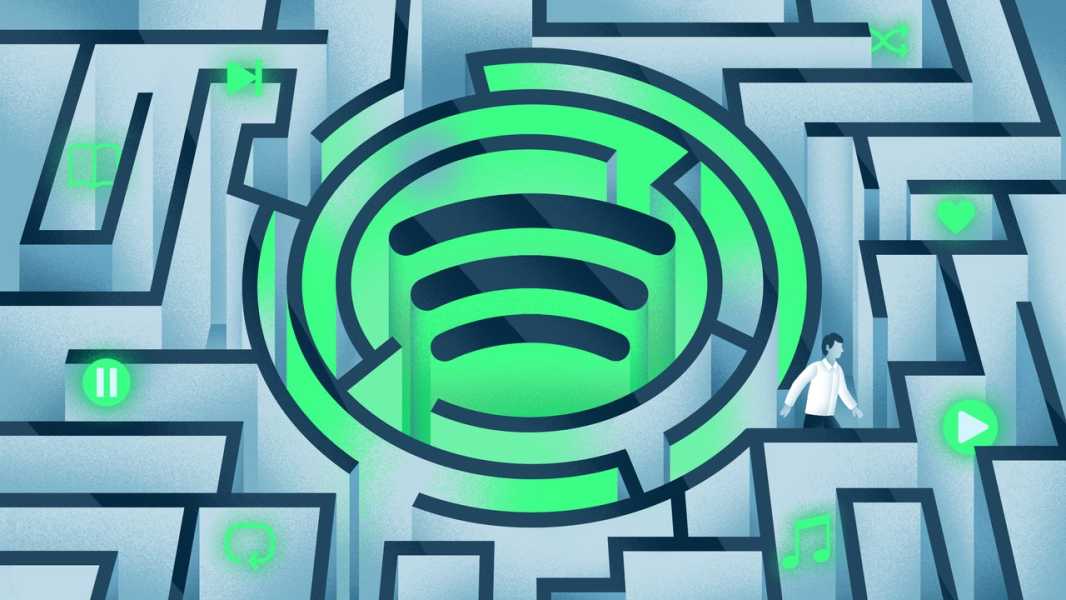
Save this storySave this storySave this storySave this story
The other week, I updated the operating system on my Mac laptop after putting the task off for many months. (One intractable flaw of technological devices: they never actually update overnight as promised.) The apps on my computer all upgraded to their latest versions, including Spotify. When I opened it back up, I found a new interface, one that began rolling out to users last year. At first glance, it didn’t look very different, though the usual three windows were more distinct from one another: a library column on the left, a central “home” window in the middle, and a view of whatever music I was currently playing on the right. But in the following days, as I used the updated app, I began to feel as though I were typing on a keyboard in a foreign language. When I tried to pull up Bill Evans Trio albums, for example, I could find only playlists. I saved Charli XCX’s “BRAT” to my library to listen to in full, but then I couldn’t track it down again. When I wanted to view my library as a whole, I couldn’t manage to make it escape the sidebar. As far I can tell, it’s impossible to do so. (The company did not respond to requests for comment for this piece.)
I realize that it sounds curmudgeonly to complain about software updates. Don’t apps provide us with enough miraculous conveniences? Through Spotify, I can browse many decades of published music more or less instantly; I can freely sample the work of new musicians. Yet it has become aggravatingly difficult to find what I want to listen to. The uppermost menu now offers three options, each given equal real estate—Music, Podcasts, and Audiobooks—and the Music tab is filled with rows of playlists, autoplay “radio” stations, and algorithmically generated mixes. The only option for browsing full albums is a small item in the lesser Library column, to the right of yet more buttons for Playlists and Podcasts. With the upgrade, it became clearer than ever what the app has been pushing me to do: listen to what it suggests, not choose music on my own. In 2012, Spotify launched its slogan, “Music for everyone.” Now it may as well be “Be grateful for whatever music we give you.”
I’m hardly alone in my souring on Spotify. When I posted about my annoyance with the interface on X, I heard from dozens of other unhappy users. “It’s harder just to enjoy music,” Kyle Austin, a marketing executive in Boston who responded to the post, told me. He’s noticed that the home-page interface emphasizes only what you’ve played recently; if you don’t want to continue listening to the same playlist or set of albums, you have to scroll past rows of recommendations or click out of the Home window. Diving deep into a particular artist’s discography—say, in Austin’s case, that of the prolific singer-songwriter Zach Bryan—requires scrolling through “Popular” tracks, “Artist Picks,” and “Popular Releases.” “It’s teaching you to not do that,” Austin said. Michael Toohey, an accountant in Chicago, told me that on Spotify “the entire concept of an album feels more like a hindrance than anything.” Music on the app is most easily consumed in a disorganized cascade; every song becomes audio “content” separated from a musician’s larger body of work. In short, Spotify does not seem to care about your relationship to “your” music anymore; for long-term users, this has felt like a slow-motion bait and switch.
As I wrote in a 2021 column, software-interface design quietly dictates so many of our online experiences today; it determines not just how we consume culture but what we consume as well. A tweak to an app’s landing page may seem minor; what’s the big deal if it takes an extra click or two to get to your library of albums? But such inconveniences have rippling effects; if albums are harder to get to, then over time they become less important as units of online listening. (The format has been increasingly destabilized for years, and famous musicians are turning more toward sprawling mixtape formats in response to the streaming ecosystem, but the shift is now affecting historical recordings, too.) Jarrett Fuller, a designer and professor at North Carolina State University, told me, “Whatever the designer decides is the default for the majority of users; that is how they will use it.” Fuller is something of a philosopher of digital design; his podcast “Scratching the Surface” canvasses experts in the field. In the past decade, he argues, a “user-centered” approach to design has been replaced by what he has taken to calling a “corporation-centered” approach. Rather than optimizing for the user’s experience, it optimizes for the extraction of profit. If Spotify succeeds at turning us all into passive listeners, then it doesn’t really matter which content the platform licenses. As Fuller put it, “It’s about ‘How do you get through as much music as you can so you keep paying for it?’ ” The company, which has hiked subscription fees multiple times in the past two years, recently reported that its profit margins are hitting new highs, up to thirty per cent. It is now spending less on licensing podcasts than it was in previous years, and its newest addition, audiobooks, looks to be even cheaper and has been a boon for engagement, according to Daniel Ek, the company’s C.E.O.
The writer Cory Doctorow coined the term “enshittification” to describe the negative consequences of such corporation-centered design. When I spoke with Doctorow the other day, he said that once companies “lock in” their users—by offering an enticing product, such as Spotify’s buffet of music—they can then “exert control over those users.” In essence, the product can afford to become incrementally worse, to test our tolerance for digital discomfort. (“Why not make things as obnoxious as possible?” Doctorow said.) We’ve seen this happen with Facebook, with Google Search, with Uber, and even with dating apps. Doctorow compared Spotify to Walmart, a monopolistic intermediary with little creative input of its own that nevertheless exerts enormous influence on the array of products we can access.
The enshittification of Spotify has been gradual. Doug Ford, who was the company’s head of editorial and music culture between 2013 and 2018, told me that in his early years there he cultivated a partnership between the engineering side of the business and the curatorial side, hiring staff to build playlists and to take charge of how particular musical genres were represented in Spotify’s catalogue. Over time, though, Ford saw the emphasis changing toward algorithmic recommendations. “Everything becomes more about personalization and lean-back listening,” he said. He continued, “I’m not anti-algorithm or A.I.; I think there needs to be a balance.” (He is currently working on a new music startup to enable playlist creation and sharing.) Issues with the listening technology create issues with the music itself; bombarded by generic suggestions and repeats of recent listening, listeners are being conditioned to rely on what Spotify feeds them rather than on what they seek out for themselves. “You’re giving them everything they think they love and it’s all homogenized,” Ford said, pointing to the algorithmic playlists that reorder tracklists, automatically play on shuffle, and add in new, similar songs. Listeners become alienated from their own tastes; when you never encounter things you don’t like, it’s harder to know what you really do.
Ultimately, I decided that I didn’t need to stream music from an app that clearly was no longer thoughtfully designed for that purpose. Instead, in mid-July, I deleted the Spotify app from my laptop. Of course, there aren’t many alternatives for a comprehensive music-streaming service. It’s a choice between technology conglomerates; YouTube, which runs YouTube Music, is owned by Google, and even the lesser-known Tidal is majority-owned by the payment-processing company Square. I decided to subscribe to Apple Music. It doesn’t solve every problem—there are still plenty of recommendations and algorithmic playlists on offer there—but it makes it easier to access a traditional view of my music library, and it doesn’t shoehorn in other types of content in a desperate bid to capture my attention. It’s cleaner, calmer, and a better listening experience. I was able to make replicas of my Spotify playlists on Apple by downloading a simple third-party app, though there were a few songs in my library, mostly vintage jazz recordings, that Spotify licenses and Apple does not. If I truly want to hold on to those tracks and make them easily accessible, I should really download them for myself and listen to them using an open-source MP3 player. ♦
Sourse: newyorker.com






